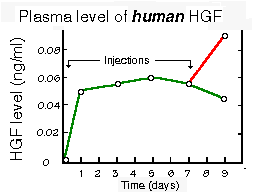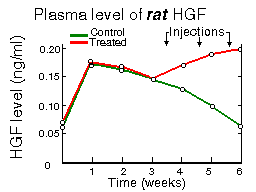|
Bryan Haycock's
Research Update column recently described a gene therapy experiment
in which an adenovirus was reprogrammed to carry genes for IGF-1 and
myosin light chain mRNA. When mice were
transfected with the engineered virus, young mice gained new muscle,
and more significantly, old mice regained muscle lost in the aging
process.
Remarkable as this experiment is, it is by no means unique. Gene therapy
is showing potential in fighting cancer, renewing damaged hearts,
overcoming muscular dystrophy, and in a myriad of other fields. For
those of us interested in the scientific aspects of bodybuilding there
are new applications showing up on almost a monthly basis that could
revolutionize the sport if applied properly. Nor are these techniques
always so high-tech and expensive that they are beyond the means of
athletes.
HGF Gene Transfer
Apart from its near-miraculous effects healing liver and
ulcers and raising the level of HDL ("good cholesterol") [Ueki1999,
Tahara1999,
Takahashi1996], Hepatocyte Growth Factor (HGF) is the first
of the growth factors to activate satellite cells after injury
(including traumatic exercise). [Gal-Levi1998,
Tatsumi1998]. Under the influence of HGF, satellite cells
proliferate, differentiate, and form new muscle. One of the ways in
which prostaglandins build muscle is by inducing secretion of HGF.
In addition to its
mitogenic effect, HGF has a potent
chemotactic and
chemokinetic effect on satellite cells. Muscle regeneration is not
solely dependent on satellite cells in the vicinity of the affected
muscle. When muscle is crushed for example, it releases HGF, which acts
as a chemical distress signal to summon muscle precursors from other
locations.
Scientists at Osaka University in Japan have used the Hemaglutinating
Virus of Japan (HVJ, also known as the "Sendai" virus) as a
vector to
transduce HGF into the muscles and liver of rats. HVJ has a big
advantage over replication-defective adenovirus (RDAd), which has been
favored by Americans. RDAd presents
antigens, leading to attack by cells of the immune system [Hirano1998].
This results in loss of persistence of the effect desired. HVJ on the
other hand can be repeatedly injected with only the most minor immune
system response [Kafri1998].
In the experiment, rats were injected with a poison called
dimethylnitrosamine (DMN) for three days each week. DMN selectively
damages the liver, causing cell destruction and fibrous scarring similar
to liver cirrhosis in humans. The illness was progressive, causing death
of all rats by the seventh week, unless they received the
HVJ virus with its recombinant human HGF payload.
Beginning after the fourth weekly administration of DMN, at a time when
damage to the livers was already widespread, rats were injected once
weekly with either 20 mg. of a HVJ-liposome
mix, 40 mg. of HVJ-liposome, or a placebo. Analyses showed the serum
level of human HGF rose quickly, remained at the higher level for a
week, and rose to an even higher level after a second injection. As
well, the rats' own endogenous HGF rose after the injections, and
remained elevated (see figures).


HGF gene therapy (from Ueki et al., 1999)
Physiologically, treatment with HVJ-HGF reduced fibrosis
by 70% and prevented
apoptosis caused by DMN. Rats given the smaller dose of HVJ-HGF
survived 26% longer, and those given the higher dose were completely
cured. All were free of cirrhosis 50 days after the beginning of the
experiment.
So this therapy cures cirrhosis, a disease that kills tens of thousands
of people each year. More relevantly for bodybuilders, it
provides a safe and reliable method for increasing HGF levels in
muscles. Although very high levels of HGF can result in tumor formation
[Takayama1997],
experiments at the U.S. National Cancer Institute show that in
transgenic mice with HGF levels 200-300% over normal, tumors were
suppressed. The transfection experiment we've described here also
produced increased HGF at this lower level. Hence treatment by
transfection is likely to be safe.
If this treatment for cirrhosis becomes widespread, it is just a matter
of time before it is used by bodybuilders to produce new gains in muscle
-- not just hypertrophy, but actual increases in the number of muscle
fibers due to activation and proliferation of satellite cells and other
muscle precursors by Hepatocyte Growth Factor.
Leptin Gene Transfer
It's not enough for a bodybuilder to have massive muscles, there also
must be a bare mimimum of fat for the seperation of the muscles to be
evident. What better way to remove fat than to increase leptin, the main
substance controlling body composition?
Scientists at Merk Laboratories in Pennsylvania have used a
second-generation helper-dependent adenovirus (HDAd) to deliver
leptin genes to both normal and genetically obese mice [Morsy1998].
Whereas first-generation adenovirus vectors produced immune reactions
and liver toxicity, the HDAd delivery system had significantly improved
safety and produced a prolonged increase in serum leptin levels,
resulting in weight loss. Actually the real problem with this system is
that it accepts such a large genetic payload (37
kilobases) that it is tempting to insert a few more genes just for
good measure...
Erythropoietin Gene Transfer
What will the Tour de France be like when the muscles of
bicycle racers can be transduced with erythropoietin (EPO), the doping
substance that gives them greater endurance by creating more blood
cells? That day may not be far off, judging from recent reports.
Credible EPO gene therapy experiments have been reported since 1994 [Tripathy1994,
Kessler1996]. Recently, a team from Chiron Corporation showed that a
single injection of an adeno- associated virus (AAV) encoded with the
EPO gene produced sustained high circulating EPO levels in monkeys. By
week #10 after the injection, the monkey's
hematocrit had doubled.
However, having a hematocrit that is too high can be as dangerous as
anemia. Therefore new experiments reported in the last two years have
sought to transfer the EPO gene in a way that production of EPO can be
fine-tuned. This is accomplished by adding a transcription factor that
can be regulated by dosing with a harmless drug like tetracycline [Ye1999,
Bohl1998,
Rendahl1998].
The Future
Gene therapy is attracting some of the best minds in
science, and the potential rewards in fighting disease are almost beyond
imagining. On the way to the lofty goals of suppressing cancer,
rebuilding damaged hearts and so on, there will be opportunities for
those of us who simply want to get stronger and look better. Imagine a
clinic in Brazil that you visit once a year to get your HGF and leptin
genes reset. Imagine a scientist at the Pasteur Institute with a
lucrative but secret practice catering to bicyclists. These technologies
exist today. They just require a modest laboratory capable of sustaining
a viral culture. It won't be long.
References
- Bohl D, Salvetti A, Moullier P, Heard JM. 1998 Sep 1.
Control of erythropoietin delivery by doxycycline in mice after
intramuscular injection of adeno-associated vector. Blood.
92(5):1512-1517.
- Gal-Levi R, Leshem Y, Aoki S, Nakamura T, Halevy O. 1998
Mar 12.
Hepatocyte growth factor plays a dual role in regulating skeletal
muscle satellite cell proliferation and differentiation. Biochim
Biophys Acta. 1402(1):39-51.
- Hirano T, Fujimoto J, Ueki T, Yamamoto H, Iwasaki T, Morisita
R, Sawa Y, Kaneda Y, Takahashi H, Okamoto E. 1998 Apr.
Persistent gene expression in rat liver in vivo by repetitive
transfections using HVJ-liposome. Gene Ther. 5(4):459-464.
- Kafri T, Morgan D, Krahl T, Sarvetnick N, Sherman L, Verma I.
1998 Sep 15.
Cellular immune response to adenoviral vector infected cells does
not require de novo viral gene expression: implications for gene
therapy. Proc Natl Acad Sci U.S.A. 95(19):11377-11382.
- Kessler PD, Podsakoff GM, Chen X, McQuiston SA, Colosi PC,
Matelis LA, Kurtzman GJ, Byrne BJ. 1996 Nov 26.
Gene delivery to skeletal muscle results in sustained expression and
systemic delivery of a therapeutic protein.
Proc.Natl.Acad.Sci.U.S.A. 93(24):14082-14007.
- Lattanzi L, Salvatori G, Coletta M, Sonnino C, et al.
1998 May
High Efficiency Myogenic Conversion of Human Fibroblasts by
Adenoviral Vector-mediated MyoD Gene Transfer. J Clin Invest.
101(10):2119-2128.
Full text]
- Morsy MA, Gu M, Motzel S, Zhao J, Lin J, Su Q, Allen H, et
al. 1998 Jul 7.
An adenoviral vector deleted for all viral coding sequences results
in enhanced safety and extended expression of a leptin transgene.
Proc Natl Acad Sci U S A. 95(14):7866-7871.
- Rendahl KG, Leff SE, Otten GR, Spratt SK, Bohl D, Van Roey M,
et al. 1998 Aug.
Regulation of gene expression in vivo following transduction by two
separate rAAV vectors. Nat Biotechnol. 16(8):757-761.
- Santoni-Rugiu E, Preisegger KH, Kiss A, Audolfsson T, Shiota
G, Schmidt EV, Thorgeirsson SS. 1996 Sep 3.
Inhibition of neoplastic development in the liver by hepatocyte
growth factor in a transgenic mouse model. Proc Natl Acad Sci U
S A. 93(18):9577-9582.
- Tahara M, Matsumoto K, Nukiwa T, Nakamura T. 1999 Feb.
Hepatocyte growth factor leads to recovery from alcohol-induced
fatty liver in rats. J Clin Invest. 103(3):313-320. [Full
text]
- Takahashi M, Ota S, Hata Y, Mikami Y, Azuma N, Nakamura T,
Terano A, Omata M. 1996 Dec 1.
Hepatocyte growth factor as a key to modulate anti-ulcer action of
prostaglandins in stomach. J Clin Invest. 98(11):2604-11. [Full
text]
- Takayama H, LaRochelle WJ, Sharp R, Otsuka T, Kriebel P,
Anver M, Aaronson SA, Merlino G. 1997 Jan 21.
Diverse tumorigenesis associated with aberrant development in mice
overexpressing hepatocyte growth factor/scatter factor. Proc
Natl Acad Sci U S A. 94(2):701-706. [Full
text]
- Tatsumi R, Anderson JE, Nevoret CJ, Halevy O, Allen RE.
1998 Feb 1.
HGF/SF is present in normal adult skeletal muscle and is capable of
activating satellite cells. Dev Biol. 194(1):114-28.
- Tripathy SK, Goldwasser E, Lu MM, Barr E, Leiden JM. 1994
Nov 22.
Stable delivery of physiologic levels of recombinant erythropoietin
to the systemic circulation by intramuscular injection of
replication- defective adenovirus. Proc.Natl.Acad.Sci.U.S.A.
91(24):11557-61.
- Ueki T, Kaneda Y, Tsutsui H, Nakanishi K, Sawa Y, Morishita
R, Matsumoto K, Nakamura T, Takahashi H, Okamoto E, Fujimoto J.
1999 Feb.
Hepatocyte growth factor gene therapy of liver cirrhosis in rats.
Nature Med. 5(2):226-230.
- Ye X, Rivera VM, Zoltick P, Cerasoli F Jr, Schnell MA, Gao G,
Hughes JV, Gilman M, Wilson JM. 1999 Jan 1.
Regulated delivery of therapeutic proteins after in vivo somatic
cell gene transfer. Science. 283(5398):88-91.
- Zhou S, Murphy JE, Escobedo JA, Dwarki VJ. 1998 May.
Adeno-associated virus-mediated delivery of erythropoietin leads to
sustained elevation of hematocrit in nonhuman primates. Gene
Ther. 5(5):665-670
|